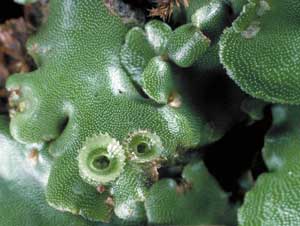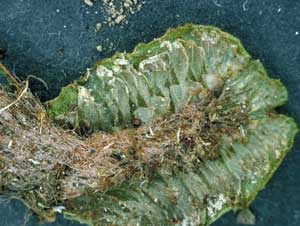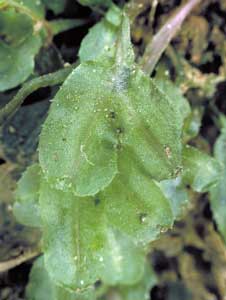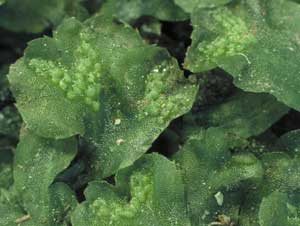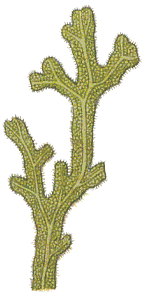
What is a liverwort?
Thallose liverworts
This page introduces you to various features you can see in the thallose liverworts. It would take considerable space to discuss all such liverworts, so you'll see just a small number of illustrative genera. However, from the examples given here, you should be able to get a good overview of thallose liverwort structure. That should help you make sense of most of the thallose liverworts you encounter. This page will tell you WHAT the various features are but there will be little about their functions or development. Such aspects are covered in other parts of this website![]() .
.
In a complex thallose liverwort the thallus is many cells thick and the cells in different layers within the thallus have different functions. A simple thallose liverwort lacks such differentiation. These are seemingly straightforward definitions but there are some grey areas since, for example, some complex thallose liverworts are much simpler than others. Despite that the terms "complex" and "simple" are still very useful since many liverworts quite clearly fall into one or other of those categories. However, there are some that have hovered on the boundary. We will look first at some of the undoubtedly complex thallose liverworts, then at some of the liverworts that are undoubtedly simple. We'll finish with a brief look at the grey area.
Complex thallose liverworts
Probably the best-known genera of liverworts are the complex thallose genera Lunularia and Marchantia. When you look at the thallus of any species in either of these genera you will see an abundance of minute, white dots on the upper surface of the thallus. These are tiny pores that lead to broader chambers, below the surface of the thallus, in which gas exchange takes place. In Lunularia (as well as some other genera) the air pores are just fairly simple holes. However, there are also complex thallose liverworts in which the pore is more complex. For example, in Marchantia, each pore is bordered by a complex of cells that gives the whole pore the appearance of a thick-sided barrel, with the top and bottom covers missing. In thallose liverworts with air pores the pores are generally static (unlike the stomata of vascular plants) but there are some exceptions. In Preissia (a northern hemisphere genus not known from Australia) the barrel-shaped pores may change to adjust the width of the opening. When turgid, the cells around the bottom of each "barrel-like" air pore keep the pore open. Under dry conditions, when the cells lose their turgor they collapse and greatly narrow the opening at the bottom of the "barrel"![]() .
.
In the Marchantia photo above you will have seen some circular cups (as well as those abundant, white, pin-prick, air pores). Those circular cups are gemma cups and here's another picture showing two such gemma cups, each containing what look like tiny green "balls", about half a millimetre in diameter ![]() . Each of those is a gemma, an aggregation of cells that can be washed or splashed out of a gemma cup by flowing water or falling raindrops. A gemma that lands in a suitable place will grow into a new gametophyte.
. Each of those is a gemma, an aggregation of cells that can be washed or splashed out of a gemma cup by flowing water or falling raindrops. A gemma that lands in a suitable place will grow into a new gametophyte.
The genus Lunularia also has gemma cups, but of a half-moon shape (hence the name Lunularia) ![]() . In this picture the gemma cups are the crescents holding those tiny, green gemmae. You can also see some crescent-shaped lips around shiny, blackish pads. Those are the antheridiophores each of which holds numerous, microscopic, sperm-producing organs (the antheridia). In this photo
. In this picture the gemma cups are the crescents holding those tiny, green gemmae. You can also see some crescent-shaped lips around shiny, blackish pads. Those are the antheridiophores each of which holds numerous, microscopic, sperm-producing organs (the antheridia). In this photo ![]() you can see small, white, bud-like protuberances on the thalli of Lunularia cruciata. These are the young archegoniophores. An archegoniophore holds the microscopic archegonia, each of which contains one egg. A fertilized egg will produce a sporophyte, In this photo
you can see small, white, bud-like protuberances on the thalli of Lunularia cruciata. These are the young archegoniophores. An archegoniophore holds the microscopic archegonia, each of which contains one egg. A fertilized egg will produce a sporophyte, In this photo ![]() you can see some Lunularia plants with spore capsules. The capsules are held, in groups of four, atop long, clear stems. The black balls are unopened capsules. On the left you can see something fuzzy and brown. That's an open capsule and the brown, fuzzy stuff is a mixture of spores and elaters. The nature and roles of elaters are dealt with in the ELATERS SECTION. Each long stem and the bulk of the somewhat umbrella-like structure at the top of the stem are part of the gametophyte. In essence, each "umbrella" has developed by the lengthening of an archegoniophore. Each of the four spore capsules has a very short stalk (or seta) by which it hangs down below the umbrella. The complex structure at the top of the clear stem is called a female receptacle or a carpocephalum. Each capsule and associated seta constitutes a sporophyte, so there are four sporophytes in each female receptacle or carpocephalum.
you can see some Lunularia plants with spore capsules. The capsules are held, in groups of four, atop long, clear stems. The black balls are unopened capsules. On the left you can see something fuzzy and brown. That's an open capsule and the brown, fuzzy stuff is a mixture of spores and elaters. The nature and roles of elaters are dealt with in the ELATERS SECTION. Each long stem and the bulk of the somewhat umbrella-like structure at the top of the stem are part of the gametophyte. In essence, each "umbrella" has developed by the lengthening of an archegoniophore. Each of the four spore capsules has a very short stalk (or seta) by which it hangs down below the umbrella. The complex structure at the top of the clear stem is called a female receptacle or a carpocephalum. Each capsule and associated seta constitutes a sporophyte, so there are four sporophytes in each female receptacle or carpocephalum.
In Marchantia the antheridiophores are flattish, star-like pads ![]() that are held up on short stalks above the leathery thallus. Groups of spore capsules develop underneath umbrella-like archegoniophores, such as shown here
that are held up on short stalks above the leathery thallus. Groups of spore capsules develop underneath umbrella-like archegoniophores, such as shown here ![]() , where several Marchantia plants are growing with a potted Acacia. Here's a top view of the archegoniophores of another species
, where several Marchantia plants are growing with a potted Acacia. Here's a top view of the archegoniophores of another species ![]() .
.
Here’s another complex thallose liverwort, Plagiochasma rupestre ![]() . In this species the thallus is strap-like, bluish-green with a waxy upper surface and numerous tiny air pores. Along the long central axis of the thalli you can see a few larger, whitish dots. These are clusters of protective scales over the areas that will develop into female or male receptacles, the male receptacles bearing groups of antheridia. Here is a closer view of one thallus
. In this species the thallus is strap-like, bluish-green with a waxy upper surface and numerous tiny air pores. Along the long central axis of the thalli you can see a few larger, whitish dots. These are clusters of protective scales over the areas that will develop into female or male receptacles, the male receptacles bearing groups of antheridia. Here is a closer view of one thallus ![]() and in this photo
and in this photo ![]() you can see some slightly raised and knobbly receptacles.
you can see some slightly raised and knobbly receptacles.
Here's a view of the underside of a Marchantia thallus, about a centimetre in width. Running along the central axis you can see the densely packed brown rhizoids, which anchor the thallus to the soil. On either side of that band of rhizoids you can see pale scales. Many complex thallose liverworts have scales on the undersides of their thalli, but the colour and size vary. Here are the strap-like thalli of Asterella drummondii ![]() . The green straps have a blackish margin because the scales underneath are dark crimson and extend just beyond the thallus margin. In the Marchantia shown above the scales stopped short of the thallus margin. The previous Asterella photograph was taken when conditions were moist. Here
. The green straps have a blackish margin because the scales underneath are dark crimson and extend just beyond the thallus margin. In the Marchantia shown above the scales stopped short of the thallus margin. The previous Asterella photograph was taken when conditions were moist. Here ![]() is exactly the same view, but with the photograph taken in dry conditions. The green straps have closed up, the outside margins rolling inwards, so that all you see are the black scales that were previously under the green, strap-like thalli. If conditions become moist, the thalli will open to once again take a green, strap-like appearance. In Asterella the capsules are also held in umbrella-like archegoniophores. Here
is exactly the same view, but with the photograph taken in dry conditions. The green straps have closed up, the outside margins rolling inwards, so that all you see are the black scales that were previously under the green, strap-like thalli. If conditions become moist, the thalli will open to once again take a green, strap-like appearance. In Asterella the capsules are also held in umbrella-like archegoniophores. Here ![]() is a view of an Asterella colony with many immature, green carpocephala and here
is a view of an Asterella colony with many immature, green carpocephala and here ![]() is a closer view of a mature carpocephalum. Here are top
is a closer view of a mature carpocephalum. Here are top ![]() and oblique
and oblique ![]() views of the archegoniophores of Reboulia hemispherica. Notice that here also the thalli have black margins, indicating black scales below.
views of the archegoniophores of Reboulia hemispherica. Notice that here also the thalli have black margins, indicating black scales below.
In the genus Targionia the thalli are green, strap-like and with black scales below. But the spore capsules are not produced on umbrellas. Instead the capsules form in pouches at the ends of the thalli. In this photo ![]() you can see a number of green, Targionia thalli, each with numerous air pores on the upper surface. There is no obvious black margin to a thallus, since the scales do not extend beyond the thallus margin. A little bit to the right of the centre of the photo you can see a black pouch that extends beyond the end of the thallus on which it has developed. Inside that pouch is a spore capsule. The black pouch is not part of the capsule, but surrounds and protects the developing capsule. At maturity the capsule inside breaks open and the pouch opens so that spores can get out. Here
you can see a number of green, Targionia thalli, each with numerous air pores on the upper surface. There is no obvious black margin to a thallus, since the scales do not extend beyond the thallus margin. A little bit to the right of the centre of the photo you can see a black pouch that extends beyond the end of the thallus on which it has developed. Inside that pouch is a spore capsule. The black pouch is not part of the capsule, but surrounds and protects the developing capsule. At maturity the capsule inside breaks open and the pouch opens so that spores can get out. Here ![]() is photo showing a number of open pouches
and here
is photo showing a number of open pouches
and here ![]() are some Targionia plants in which the thalli have dried and closed up, leaving just the capsule-containing pouches visible.
are some Targionia plants in which the thalli have dried and closed up, leaving just the capsule-containing pouches visible.
Riccia is a distinctive genus, the thalli growing in V or Y shapes, often in rosettes ![]() . There are about 20 species in Australia, and about 200 worldwide. It is a very common genus of exposed areas, including very dry areas where the thalli can appear in abundance fairly soon after good rainfall. This photo
. There are about 20 species in Australia, and about 200 worldwide. It is a very common genus of exposed areas, including very dry areas where the thalli can appear in abundance fairly soon after good rainfall. This photo ![]() shows numerous Riccia plants in a moist, roadside depression in central New South Wales. The camera lens cap in the bottom left hand corner is 50 millimetres in diameter. The density of Riccia plants shown in this photo continued over an area of about 10 metres in length and a metre or so in width. Depending on species, Riccia thalli may have hairs
shows numerous Riccia plants in a moist, roadside depression in central New South Wales. The camera lens cap in the bottom left hand corner is 50 millimetres in diameter. The density of Riccia plants shown in this photo continued over an area of about 10 metres in length and a metre or so in width. Depending on species, Riccia thalli may have hairs ![]() , white scales or blackish scales seen along the margin of the thallus
, white scales or blackish scales seen along the margin of the thallus ![]() . As with some of the other liverworts mentioned above, the thalli of Riccia roll up in dry conditions. Here,
. As with some of the other liverworts mentioned above, the thalli of Riccia roll up in dry conditions. Here, ![]() for example, is a picture of a black-scaled Riccia, with the thallus inrolled, so as to show just the black scales. The antheridia, archegonia and sporophytes of Riccia are held within the thalli. In this photograph
for example, is a picture of a black-scaled Riccia, with the thallus inrolled, so as to show just the black scales. The antheridia, archegonia and sporophytes of Riccia are held within the thalli. In this photograph ![]() you can see several thalli with a number of small holes, showing as slightly yellowish or brownish (especially where the thalli are whitish). These are the openings to the antheridial or archegonial chambers within the thalli.
you can see several thalli with a number of small holes, showing as slightly yellowish or brownish (especially where the thalli are whitish). These are the openings to the antheridial or archegonial chambers within the thalli.

The species of Riccia vary in size and internal structure. The air chambers and photosynthesizing cells are in the upper half of the thallus, with food-storage cells in the lower half. The upper surfaces of Riccia thalli may be convex or concave, depending on species, and in the latter case the thalli are often somewhat V-shaped in cross-section. The stylized cross-section above shows where the archegonial and antheridial chambers are to be found in some of the Riccia species. An archegonial chamber is shown in red, an antheridial chamber in blue and, in each case, you can see the necks that lead from the chambers to the thallus surface. These necks are necessary to allow the sperm from an antheridium to get out and also for the sperm to be able to reach the eggs contained within the archegonia. The antheridial and archegonial necks typically protrude a little above the thallus surface. Once an egg in the archegonium has been fertilized a spore capsule will form within the thallus. Typically, when the spores are mature, the upper surface of the capsule and the nearby thallus cells disintegrate to create a hole and so expose the spores. In this photograph ![]() you can see some thalli with sizeable holes. Near the centre of this picture
you can see some thalli with sizeable holes. Near the centre of this picture ![]() you can see another Riccia thallus with a sizeable hole. In each case those holes have arisen from disintegration of the thalli around the mature spore capsules. Note that in some of the flimsier Riccia species there is not such a demarcation between the upper and lower thallus and the capsules may create bulges in the thallus underside.
you can see another Riccia thallus with a sizeable hole. In each case those holes have arisen from disintegration of the thalli around the mature spore capsules. Note that in some of the flimsier Riccia species there is not such a demarcation between the upper and lower thallus and the capsules may create bulges in the thallus underside.
Incidentally, while some shade of green is the norm in Riccia, there are striking exceptions. In this photo ![]() there are large colonies of two species of Riccia. Riccia limbata is dark green and Riccia albida is white. That photo shows the view from adult head height. Here
there are large colonies of two species of Riccia. Riccia limbata is dark green and Riccia albida is white. That photo shows the view from adult head height. Here ![]() is a closer view of some of the plants of Riccia albida. In this species the plants are sometimes totally white, the colour coming from encrustations of calcite or gypsum in the walls of the upper surface.
is a closer view of some of the plants of Riccia albida. In this species the plants are sometimes totally white, the colour coming from encrustations of calcite or gypsum in the walls of the upper surface.
Simple thallose liverworts
The thalli in simple thallose liverworts are thin and often translucent. In many species the thalli are also relatively small so that, if you are unfamiliar with them, you could mistake a simple thallose liverwort for a leafy liverwort or a moss. Here is a photo of the simple thallose liverwort Symphyogyna podophylla. The gametophytes will often just grow along the ground but in their finest development they are shortly stalked, with lobes radiating from the stalk apices. In this photo the lobes are about 5-10mm long and you can see a slightly thicker central axis running the length of a lobe, with thinner wings on either side. It's not too hard to understand how Symphyogyna could initially be mistaken for a moss – with that central axis taken as the midrib in a leaf. As explained in WHICH BRYOPHYTE IS IT? if it's a leaf with a midrib, it's a moss. However, to be a moss there need to be leaves on stems and that's not the case in Symphyogyna. All you have is a sheet-like thallus - there are no stems with leaves.
The sporophytes of the mosses and simple thallose liverworts are quite different and these are compared in the WHICH BRYOPHYTE IS IT? section. However, the sporophytes of leafy and simple thallose liverworts can be quite similar, a splitting or disintegrating spore capsule atop a translucent seta.
In the photo you can see parts of the Symphyogyna thallus with a speckled appearance. That's not because of air pores. Rather, the cell walls and cell surfaces reflect light in different ways to give that speckled look. Given the thin thallus gases can very easily get into and out of the thallus cells without the need for specific gas exchange chambers or air pores.
In the Symphyogyna thallus there is a slightly thickened central axis, with thin wings growing off from either side of that axis. As you can see from the Symphyogyna photograph above, a thallus can fork and each fork will have its own thickened, central axis. That basic structure is common in many of the simple thallose liverworts. But the wings or lobes that grow off the central axes need not be flat and the genus Fossombronia produces good examples of non-flat growth off the central axes. Each axis grows along the ground but the off-axis growth is typically convoluted and raised, so that at first glance the whole gametophyte looks a bit like a miniature lettuce ![]() . Because of that convoluted appearance many people at first think that they are looking at a small moss with short, upright, leafy stems. However, a closer look quickly shows the absence of leaves and the sporophytes
. Because of that convoluted appearance many people at first think that they are looking at a small moss with short, upright, leafy stems. However, a closer look quickly shows the absence of leaves and the sporophytes ![]() have flimsy, translucent setae topped with black, globular spore capsules that break open
have flimsy, translucent setae topped with black, globular spore capsules that break open ![]() . What may seem surprising for such a seemingly fragile plant, is that species of Fossombronia are common in the semi-arid areas. If conditions become too hot and dry the plants produce tiny, underground tubers and the plants die down to these, just as is the case with various tuberous, flowering plants. With good rains fresh thalli will grow from the tubers. The tubers are produced at the ends of the main axes and these turn down into the ground during tuber formation. This photograph
. What may seem surprising for such a seemingly fragile plant, is that species of Fossombronia are common in the semi-arid areas. If conditions become too hot and dry the plants produce tiny, underground tubers and the plants die down to these, just as is the case with various tuberous, flowering plants. With good rains fresh thalli will grow from the tubers. The tubers are produced at the ends of the main axes and these turn down into the ground during tuber formation. This photograph ![]() shows a Fossombronia with tubers and you can also see the anchoring rhizoids that have developed along the main axis.
shows a Fossombronia with tubers and you can also see the anchoring rhizoids that have developed along the main axis.
This photograph ![]() shows part of a colony of Aneura alterniloba and you can see a number of green thalli. There is also one immature sporophyte, with the seta just beginning to lengthen, but the whole sporophyte is still contained within a protective sheath . Remember that there's more about the growing sporophyte in the SPOROPHYTE DEVELOPMENT SECTION. In this species the capsule is slightly elongated, rather than globular as in Fossombronia. However, like Fossombronia it has a translucent seta and, in general terms, is very similar to the Fossombronia sporophyte.
shows part of a colony of Aneura alterniloba and you can see a number of green thalli. There is also one immature sporophyte, with the seta just beginning to lengthen, but the whole sporophyte is still contained within a protective sheath . Remember that there's more about the growing sporophyte in the SPOROPHYTE DEVELOPMENT SECTION. In this species the capsule is slightly elongated, rather than globular as in Fossombronia. However, like Fossombronia it has a translucent seta and, in general terms, is very similar to the Fossombronia sporophyte.
In some species of Riccardia the thallus branching can be carried to such an extreme that the resemblance to a leafy bryophyte becomes very strong ![]() .
.
In the photo (right) you can see what looks like groups of brighter green blisters on several thalli of Symphyogyna podophylla. Each of those "blisters" consists of an antheridium with overlying scales and the "blisters" are clustered around the central axes of the thalli. Symphyogyna podophylla has separate male and female plants, with the males generally smaller and less branched than the females. On the female plants the archegonia (each with an overlying scale) also develop along the central axes. There are none of the prominent structures you see in some of the complex thallose liverworts, such as the archegoniophores and antheridiophores of Marchantia for example. Similarly, for the other simple thallose liverworts, the antheridia and archegonia develop in small "blisters" or slight depressions in the thallus, typically with some surrounding or overlying scales. There is of course variation in the finer structure of the antheridial or archegonial arrangement and housing.
Simply complex...or complexly simple?
The Sphaerocarpos thalli grow in a rosette-like form and are small, mostly under a centimetre in diameter. There are separate male and female thalli, with the male thalli being smaller than the female ones. In the central area each thallus is many cells thick. From this thickened portion irregular lobes extend outward. While each of these lobes is composed of many cells, they are arranged in a sheet-like form that is just one cell thick. Rhizoids are produced below the thickened area of the thallus. In contrast to the other complex thallose liverworts the thalli of Sphaerocarpos are rather delicate and are adapted to short growth seasons. They are short-lived, typically producing spores in spring/summer from which next year's growth will appear. The males produce antheridia in tiny purplish, tubular "bottles" on the thallus surface. The female plants produce archegonia in larger "bottles" and it is usually these that you notice when you see a colony of Sphaerocarpos, since they dominate and swamp the thallus. This photograph shows the species Sphaerocarpos texanus ![]() . You can see numerous bottle-like or flask-like structures, each with a tiny hole at the top. Each of the larger flasks is a chamber surrounding one archegonium and the smaller flasks contain antheridia. In the photo you cannot see the thallus itself, since it is small and obscured by the chambers. Sphaerocarpos and some closely related genera are sometimes referred to as Bottle Hepatics, because of those bottle-like chambers.
. You can see numerous bottle-like or flask-like structures, each with a tiny hole at the top. Each of the larger flasks is a chamber surrounding one archegonium and the smaller flasks contain antheridia. In the photo you cannot see the thallus itself, since it is small and obscured by the chambers. Sphaerocarpos and some closely related genera are sometimes referred to as Bottle Hepatics, because of those bottle-like chambers.
The genus Monoclea is found in New Zealand and Central to South America. The thalli are broadly lobed, with the lobes up to 20 centimetres long and 5 centimetres wide. The lobes fork and by such repeated forking can form very large colonies. The antheridia are borne in raised antheridial pads, similar to the antheridial pads in some other complex thallose liverworts. However the sporophyte is unlike those of other complex thallose liverworts. It consists of an elongated capsule on a translucent seta, which splits open along one seam to expose the spores ![]() . This is much more like the sporophytes of leafy or simple thallose liverworts than those of other complex thallose species.
. This is much more like the sporophytes of leafy or simple thallose liverworts than those of other complex thallose species.
![An Australian Government Initiative [logo]](/images/austgovt_brown_90px.gif)


